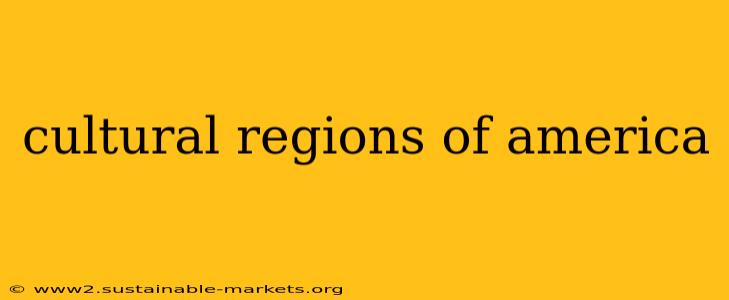America, a vast and dynamic nation, isn't a monolith. Its cultural landscape is a rich tapestry woven from the threads of countless immigrant groups, indigenous traditions, and regional identities. Understanding these distinct cultural regions offers a deeper appreciation for the nation's complexity and its vibrant, ever-evolving identity. This exploration will delve into the major cultural regions, acknowledging the fluidity and overlap inherent in such classifications.
Defining Cultural Regions: More Than Just Geography
Defining cultural regions isn't simply a matter of drawing lines on a map. While geography plays a crucial role, shaping access to resources and influencing settlement patterns, culture is also shaped by history, ethnicity, religion, economics, and social structures. These interwoven factors create distinct regional identities, reflected in everything from cuisine and music to dialect and social norms.
Major Cultural Regions of the United States:
While numerous sub-regions exist, several major cultural regions stand out:
1. The Northeast: A Melting Pot of History and Innovation
The Northeast, encompassing New England and the Mid-Atlantic states, boasts a rich history deeply intertwined with European colonization. This region's cultural identity is a complex blend of Puritan heritage, industrial revolution legacy, and waves of immigration.
- Key Cultural Traits: A strong emphasis on education and intellectualism, a vibrant arts and culture scene, distinctive accents, and a blend of historical preservation and modern innovation. Think Boston's literary legacy, New York City's cosmopolitan energy, and Philadelphia's historical significance.
2. The South: A Blend of Tradition and Transformation
The South, extending from Virginia to Texas, possesses a unique cultural heritage profoundly shaped by its agrarian past, the Civil War, and the enduring influence of African American culture. This region is known for its hospitality, its distinct musical traditions (blues, country, gospel), and its complex racial history, which continues to shape its identity.
- Key Cultural Traits: Strong religious affiliations, a slower pace of life in some areas, distinctive culinary traditions (barbecue, soul food), and a rich literary and musical heritage.
3. The Midwest: Heartland Values and Industrial Might
The Midwest, encompassing the states around the Great Lakes and extending westward, is often seen as the "heartland" of America. Characterized by its agricultural roots and its significant industrial past, this region exhibits a strong sense of community and a down-to-earth ethos.
- Key Cultural Traits: A strong work ethic, a focus on family and community, a pragmatic approach to life, and a distinct regional dialect.
4. The West: Rugged Individualism and Natural Beauty
The West, encompassing the states from the Rocky Mountains to the Pacific Ocean, is defined by its vast landscapes, its frontier history, and its embrace of rugged individualism. Native American cultures have profoundly impacted the region's cultural identity, alongside the legacies of Spanish colonization and the Gold Rush.
- Key Cultural Traits: An appreciation for outdoor recreation, a strong sense of independence, a diverse population, and a growing technological sector (especially in California's Silicon Valley).
5. The Southwest: A Blend of Cultures
The Southwest, encompassing states like Arizona, New Mexico, and parts of California, Texas, and Colorado, showcases a unique blend of Native American, Spanish, and Mexican influences. This region is characterized by its arid landscapes, its distinctive architecture (adobe and Spanish colonial styles), and its rich culinary traditions.
- Key Cultural Traits: A strong connection to the land, a vibrant arts and crafts tradition, a diverse linguistic landscape, and a rich culinary heritage influenced by Hispanic and Native American traditions.
Understanding the Nuances: Overlap and Evolution
It's crucial to remember that these cultural regions are not rigidly defined. There's considerable overlap and blending between them. Furthermore, these regions are constantly evolving. Globalization, migration, and technological advancements continue to reshape cultural identities, creating a dynamic and ever-changing American landscape. This ongoing evolution adds to the richness and complexity of the nation's cultural mosaic.

